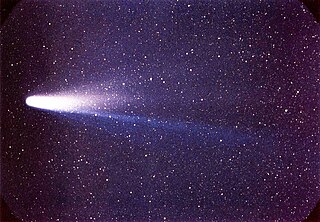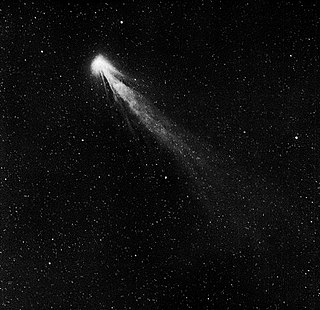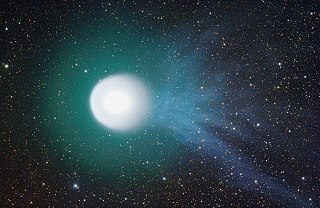
Halley's Comet, Comet Halley, or sometimes simply Halley, officially designated 1P/Halley, is a short-period comet visible from Earth every 75–79 years. Halley is the only known short-period comet that is regularly visible to the naked eye from Earth, and thus the only naked-eye comet that can appear twice in a human lifetime. It last appeared in the inner parts of the Solar System in 1986 and will next appear in mid-2061.

Comet Hyakutake is a comet discovered on 31 January 1996. It was dubbed the Great Comet of 1996; its passage to within 0.1 AU (15 Gm) of the Earth on 25 March was one of the closest cometary approaches of the previous 200 years. Reaching an apparent visual magnitude of zero and spanning nearly 80°, Hyakutake appeared very bright in the night sky and was widely seen around the world. The comet temporarily upstaged the much anticipated Comet Hale–Bopp, which was approaching the inner Solar System at the time.

Comet Ikeya–Seki, formally designated C/1965 S1, 1965 VIII, and 1965f, was a long-period comet discovered independently by Kaoru Ikeya and Tsutomu Seki. First observed as a faint telescopic object on September 18, 1965, the first calculations of its orbit suggested that on October 21, it would pass just 450,000 km (280,000 mi) above the Sun's surface, and would probably become extremely bright.

Comet Encke, or Encke's Comet, is a periodic comet that completes an orbit of the Sun once every 3.3 years. Encke was first recorded by Pierre Méchain on 17 January 1786, but it was not recognized as a periodic comet until 1819 when its orbit was computed by Johann Franz Encke. Like Halley's Comet, it is unusual in its being named after the calculator of its orbit rather than its discoverer. Like most comets, it has a very low albedo, reflecting only 4.6% of the light its nucleus receives, although comets generate a large coma and tail that can make them much more visible during their perihelion. The diameter of the nucleus of Encke's Comet is 4.8 km.
Damocloids are a class of minor planets such as 5335 Damocles and 1996 PW that have Halley-type or long-period highly eccentric orbits typical of periodic comets such as Halley's Comet, but without showing a cometary coma or tail. David Jewitt defines a damocloid as an object with a Jupiter Tisserand invariant (TJ) of 2 or less, while Akimasa Nakamura defines this group with the following orbital elements:

Comet Humason, formally designated C/1961 R1, was a non-periodic comet discovered by Milton L. Humason on September 1, 1961. Its perihelion was well beyond the orbit of Mars, at 2.133 AU. The outbound orbital period is about 2516 years. The diameter of its comet nucleus is estimated at 30−41 km.

Comet Bennett, formally known as C/1969 Y1, was one of the two bright comets observed in the 1970s, along with Comet West and is considered a great comet. The name is also borne by an altogether different comet, C/1974 V2. Discovered by John Caister Bennett on December 28, 1969, while still almost two AUs from the Sun, it reached perihelion on March 20, passing closest to Earth on March 26, 1970, as it receded, peaking at magnitude 0. It was last observed on February 27, 1971.

13P/Olbers is a periodic comet with an orbital period of 69 years. It fits the classical definition of a Halley-type comet with. The comet had last been seen in 1956 and the next perihelion is on 30 June 2024.

Comet Holmes is a periodic comet in the Solar System, discovered by the British amateur astronomer Edwin Holmes on November 6, 1892. Although normally a very faint object, Holmes became notable during its October 2007 return when it temporarily brightened by a factor of a million, in what was the largest known outburst by a comet, and became visible to the naked eye. It also briefly became the largest object in the Solar System, as its coma expanded to a diameter greater than that of the Sun. Between 1857–2106 perihelion remains between 2.05–2.36 AU.

Comet McNaught, also known as the Great Comet of 2007 and given the designation C/2006 P1, is a non-periodic comet discovered on 7 August 2006 by British-Australian astronomer Robert H. McNaught using the Uppsala Southern Schmidt Telescope. It was the brightest comet in over 40 years, and was easily visible to the naked eye for observers in the Southern Hemisphere in January and February 2007.

Comet 96P/Machholz or 96P/Machholz 1 is a short-period sungrazing comet discovered on May 12, 1986, by amateur astronomer Donald Machholz on Loma Prieta peak, in central California using 130 millimetres (5.1 in) binoculars. On June 6, 1986, 96P/Machholz passed 0.404 AU from the Earth. 96P/Machholz last came to perihelion on January 31, 2023. The comet has an estimated diameter of around 6.4 km (4.0 mi).

23P/Brorsen–Metcalf is a periodic comet with an orbital period of 70 years. It fits the classical definition of a Halley-type comet with. It was first discovered by Theodor Brorsen at the Altona Observatory on July 20, 1847, and again by Kaspar Schweizer (Moscow) on August 11, 1847. It was predicted that it would reappear between 1919 and 1922.

Comet Lulin is a non-periodic comet. It was discovered by Ye Quanzhi and Lin Chi-Sheng from Lulin Observatory. It peaked in brightness at magnitude between +4.5 and +5, becoming visible to the naked eye, and arrived at perigee for observers on Earth on February 24, 2009, and at 0.411 AU from Earth.

The Great Southern Comet of 1887, or C/1887 B1 using its International Astronomical Union (IAU) designation, was a bright comet seen from the Southern Hemisphere during January 1887. Later calculations indicated it to be part of the Kreutz Sungrazing group. It came to perihelion on 11 January 1877 at a distance of 0.00483 AU (723 thousand km) with a velocity of 606.1 km/s. Since the Sun has a radius of 696000 km, the comet passed about 27000 km from the surface of the Sun.

The Great Comet of 1901, sometimes known as Comet Viscara, formally designated C/1901 G1, was a comet which became bright in the spring of 1901. Visible exclusively from the southern hemisphere, it was discovered on the morning of April 12, 1901 as a naked-eye object of second magnitude with a short tail. On the day of perihelion passage, the comet's head was reported as deep yellowish in color, trailing a 10-degree tail. It was last seen by the naked eye on May 23.

C/1807 R1, also known as the Great Comet of 1807, is a long-period comet. It was visible to naked-eye observers in the northern hemisphere from early September 1807 to late December, and is ranked among the great comets due to its exceptional brightness.

C/1769 P1 (Messier) is a long-period comet that was visible to the naked eye at its last apparition in 1769. The comet is classified as a great comet due to its superlative brightness.

Comet 252P/LINEAR is a periodic comet and near-Earth object discovered by the LINEAR survey on April 7, 2000. The comet is a Jupiter family comet, meaning that it passes quite close to the orbit of Jupiter.

C/2021 A1 (Leonard) was a long period comet that was discovered by G. J. Leonard at the Mount Lemmon Observatory on 3 January 2021 when the comet was 5 AU (750 million km) from the Sun. It had a retrograde orbit. The nucleus was about 1 km (0.6 mi) across. It came within 4 million km (2.5 million mi) of Venus, the closest-known cometary approach to Venus.

C/2022 E3 (ZTF) is a non-periodic comet from the Oort cloud that was discovered by the Zwicky Transient Facility (ZTF) on 2 March 2022. The comet has a bright green glow around its nucleus, due to the effect of sunlight on diatomic carbon and cyanogen. The comet's systematic designation starts with C to indicate that it is not a periodic comet, and "2022 E3" means that it was the third comet to be discovered in the first half of March 2022.





















